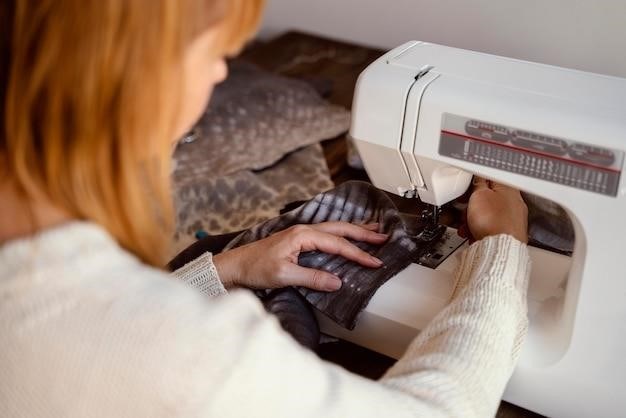Babylock Repair Manual⁚ A Comprehensive Guide
This manual provides a step-by-step guide to maintaining and repairing your Babylock sewing machine. From basic cleaning to advanced troubleshooting, we’ll help you keep your machine sewing smoothly. Learn to identify problems and find solutions efficiently.
Babylock sewing machines are renowned for their innovative features and high-quality construction, offering a wide range of functionalities for both beginners and experienced sewists. Known for their versatility, Babylocks excel in various sewing techniques, including serging, overlocking, and decorative stitching. Understanding the specific model you own is crucial for effective repair and maintenance. These machines often incorporate advanced technology, such as computerized stitch selection and automatic needle threading, which contribute to their efficiency and precision. Proper care and maintenance are essential to maximize the lifespan and performance of your Babylock machine. Regular cleaning and lubrication will prevent problems and ensure smooth operation. This manual will guide you through the process, providing valuable insights into the inner workings of your Babylock and enabling you to troubleshoot common issues effectively. By following the instructions carefully, you’ll be equipped to handle most minor repairs yourself, extending the life of your valuable sewing machine.

Identifying Your Babylock Model

Accurately identifying your Babylock sewing machine model is the first crucial step in any repair or maintenance process. Your model number provides access to specific manuals, parts diagrams, and troubleshooting guides tailored to your machine’s unique design and features. The model number is typically located on a label affixed to the machine itself, often on the front or underside. This label may also contain other important information such as the serial number and manufacturing date. Take a clear photograph of this label for future reference. If you cannot locate the label on the machine, consult your original purchase documents or contact Babylock customer support for assistance. They can help identify your model based on its physical characteristics and any available documentation you might have. Once you know your model number, you can easily access the appropriate resources online or through authorized Babylock dealers. Having this information readily available will significantly streamline the repair process and ensure you receive the most accurate and helpful guidance.
Common Babylock Problems and Troubleshooting
Many common Babylock sewing machine issues stem from simple problems easily solved at home. Skipped stitches often result from improper threading, a bent needle, or a dull needle. Check your threading path carefully, replacing the needle if necessary. Jammed thread can be caused by lint build-up or a tangled bobbin. Clean your machine thoroughly and ensure the bobbin is correctly wound and inserted. If your machine is making unusual noises, such as loud clicking or grinding, it may indicate a need for lubrication or a more serious mechanical issue. Consult your machine’s manual for specific lubrication points. Uneven stitch length might be due to incorrect tension settings. Adjust the tension dials, testing with scraps of fabric until the stitch is even. If your machine fails to start, check the power cord and ensure the power switch is on. Remember to always unplug your machine before performing any internal cleaning or adjustments. For persistent problems, or if you’re unsure how to proceed, refer to your machine’s manual or seek professional assistance.
Basic Maintenance and Cleaning
Regular cleaning is crucial for maintaining your Babylock sewing machine’s performance and longevity. Begin by unplugging the machine and gently brushing away loose lint and dust using a soft brush or compressed air. Pay close attention to areas around the feed dogs, bobbin case area, and needle plate. A small vacuum cleaner with a brush attachment can be helpful for reaching tight spaces. Remove the needle plate and carefully clean any accumulated debris. Check for broken needle fragments or bent parts. Wipe down the exterior of the machine with a damp (not wet) cloth. Avoid using harsh chemicals or abrasive cleaners. Periodically, inspect the internal components such as the hook assembly, checking for any sign of wear or damage. Remember, proper cleaning prevents jams, skipped stitches, and other operational problems. While cleaning, take the opportunity to visually inspect belts and other moving parts to ensure they are intact and properly functioning. Regular, preventative maintenance is significantly more efficient than tackling serious problems later.
4.1 Cleaning the Bobbin Case
The bobbin case is a critical component, and regular cleaning prevents malfunctions. Begin by removing the bobbin case from your Babylock machine. Carefully remove the bobbin. Using a soft brush, gently remove any lint, dust, or thread fragments from the bobbin case. Pay particular attention to the hook raceway, ensuring it’s free from obstructions. A small, pointed tool, such as a toothpick or a specialized cleaning tool, can help dislodge stubborn debris. Inspect the bobbin case for any damage, such as dents or cracks. If you notice any damage, it’s advisable to replace the bobbin case to avoid sewing problems. After cleaning, reinsert the bobbin into the case, ensuring it’s properly seated. Carefully check the tension of the bobbin case. If the tension is off, the machine will not sew correctly. Incorrect tension often leads to skipped stitches or uneven stitch formation. Finally, reinsert the bobbin case into the machine, ensuring it’s correctly aligned and clicks into place. Regular cleaning of this essential part will contribute to the smooth operation of your Babylock machine.
4.2 Lubrication and Oiling
Regular lubrication is crucial for maintaining your Babylock sewing machine’s performance and longevity. Consult your machine’s specific manual for recommended lubrication points and the type of oil to use. Generally, high-quality sewing machine oil is recommended, avoiding household oils that may damage the machine’s internal components. Before lubricating, ensure the machine is unplugged and switched off for safety. Use a small oil bottle with a fine tip applicator to precisely target lubrication points. Apply only a small amount of oil to each designated area, avoiding excessive oiling which can attract dust and lint. Focus on moving parts like the needle bar, hook assembly, and other moving mechanisms. Avoid oiling the motor itself. After oiling, run the machine for a short period to distribute the oil evenly. Wipe away any excess oil with a soft, lint-free cloth. Regular lubrication helps to reduce friction, minimizes wear and tear on moving parts, and ensures smoother operation. Remember to check your machine’s lubrication needs periodically, as recommended in your owner’s manual, to keep your Babylock running smoothly for years to come. Neglecting lubrication can lead to increased friction and damage.
Advanced Repair Techniques
Attempting advanced repairs requires a good understanding of your Babylock machine’s mechanics. This section outlines some more complex procedures; however, always consult your machine’s specific manual before undertaking any significant repair. Replacing internal parts like the timing belt or hook assembly demands precision and technical skill. Incorrect installation can lead to further damage. If you lack experience with these tasks, it’s strongly recommended to seek professional assistance. Diagnosing issues like timing problems necessitates careful observation and potentially specialized tools. Understanding the internal workings of the machine, including the feed dog mechanism and tension system, is essential for successful repair. Working with the internal electrical components requires caution and expertise to prevent electrical shock. Improper handling of electrical components can cause irreparable damage to the machine or even personal injury. Replacing circuit boards or other electronic components is best left to qualified technicians. Remember, safety is paramount; if you are unsure about any step, stop and seek professional help. Improper repairs can void warranties and potentially cause further harm.
Understanding Your Babylock’s Manual
Your Babylock sewing machine’s manual is an invaluable resource. It contains detailed diagrams, troubleshooting guides, and specifications unique to your model. Familiarize yourself with its contents, paying close attention to the sections on lubrication, tension adjustment, and needle placement. The manual often provides exploded diagrams showing the internal components, aiding in part identification during repairs. Understanding the diagrams will help you locate specific parts and understand their functions within the machine’s overall mechanism. Refer to the troubleshooting section to identify and solve common problems before resorting to more complex repairs. The manual might also include safety precautions and warnings crucial for safe operation and maintenance. Learn to interpret the different symbols and codes used throughout the manual for easy navigation and understanding. Regularly consult your manual, even for routine tasks, to ensure proper operation and prolong the life of your machine. Maintaining a clean and organized manual will ensure easy access to vital information when needed. Keep the manual in a safe and accessible place to avoid unnecessary delays during troubleshooting or repairs.
Finding Replacement Parts
Locating replacement parts for your Babylock sewing machine is crucial for successful repairs. Begin by identifying the exact model number of your machine; this is usually found on a sticker on the machine itself. Your Babylock’s manual might list authorized dealers or service centers where you can order genuine parts. These parts are designed specifically for your machine and guarantee optimal performance and longevity. Online retailers specializing in sewing machine parts are another excellent resource. Ensure you’re purchasing parts from reputable sellers to avoid counterfeit or incompatible components. When ordering, always double-check the part number to ensure compatibility with your Babylock model. Many online forums and communities dedicated to sewing machines can offer guidance on finding specific parts or alternative suppliers. Consider keeping a small inventory of commonly used parts, such as needles, bobbins, and belts, to minimize downtime during minor repairs. Before ordering expensive components, consider the cost of repair versus the cost of replacing the entire machine. Remember to carefully inspect any received part for damage before installation.
When to Call a Professional
While many Babylock repairs can be handled at home, some situations necessitate professional intervention. If you encounter significant internal damage, such as broken gears or severely damaged components that you cannot identify or access, contacting a professional is crucial. Electrical problems, including shocks or malfunctions, should never be attempted without expert assistance. If after following troubleshooting steps, your machine remains inoperable or continues to malfunction, it’s best to seek professional help. Complex repairs involving intricate internal mechanisms are best left to trained technicians with specialized tools and expertise. If you lack confidence in your repair skills or are unsure about a specific issue, seeking professional advice is always recommended. Attempting complex repairs without proper knowledge can lead to further damage, increasing repair costs. Consider the cost of potential further damage versus the cost of professional repair. A professional can diagnose the problem accurately and efficiently, saving you time and money in the long run. Finding a reputable Babylock service center or authorized repair technician is essential for reliable and efficient repairs.
Safety Precautions During Repair
Before attempting any repair, always unplug your Babylock sewing machine from the power source. This prevents accidental electric shocks and ensures your safety. Never attempt repairs while the machine is plugged in or turned on. When working with internal components, be mindful of sharp edges and moving parts. Use appropriate tools to avoid injury, and wear safety glasses to protect your eyes from flying debris. If working with lubricants or cleaning solutions, ensure proper ventilation and avoid skin contact. Refer to the safety guidelines provided in your Babylock’s user manual for specific warnings regarding your model. If you are unsure about any aspect of the repair process, it’s always best to err on the side of caution and seek professional assistance. Remember that improper handling can lead to injury or further damage to your machine. Keep a clean and organized workspace to prevent accidents. Never force components; if something doesn’t fit or move easily, stop and re-evaluate your approach. Prioritize safety throughout the entire repair process to avoid injury and ensure a successful outcome.